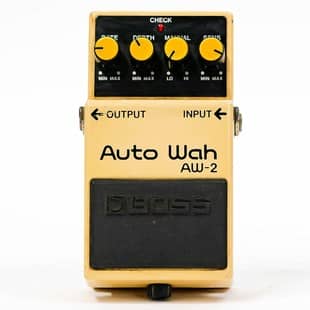Manual wah or auto-wah? Although they produce similar sounds, how do you choose the right fit for you?
In this post, you’ll learn the key differences to help you make a decision for your next wah.
What is the difference between a wah pedal and auto-wah?
A traditional wah pedal is an expression-based effect allowing a player to control the ‘wah sweep’ with the foot. In comparison, an auto-wah pedal creates an envelope filter loop that can be controlled with the pedal’s parameters and is more sensitive to picking dynamics.

Traditional Wah Pedal
Pros
- More intuitive dynamics
- More Expresive
- Combines superbly with Distortion/Overdrive/Fuzz pedals
- Simpler to use
- Easy for beginners
- Manual Wah Pedals are a lifetime pedal
Cons
- Less tonal effects
- Full-size pedals take up more pedalboard room
- Slightly more expensive
- Not battery operated
Manual Wah (Best Choice If…)
- You want manual control over the sweep and dynamics of the wah effect
- You want to actuate specific notes and chords, adding more texture to your playing
- You want to ‘learn ‘wah control basics
- You are a beginner and want a simple pedal with less complicated controls
- You play heavier genres of music as they are more popular with manual wah pedals
- You prefer the sound of a ‘natural’ sound of ‘human-controlled’ wah
- You like to use dirt pedals in your sound (distortion, fuzz, overdrive)
Auto-Wah – Pros & Cons
Pros
- More tonal options (with more advanced pedals)
- Create a custom wah sound
- ‘Choppy’ sound
- Allows you to concentrate on playing
- Set it and forget it
- Dynamic response to your picking dynamics
- Don’t need to operate an expression pedal
- Many affordable options to choose from
Cons
- Some argue they ‘sap the tone’ from your signal
- Sound a little ‘robotic’
- Confusing to beginners
- Difficult to dial in a wah sound ‘on the fly’
- Don’t react as well to high-gain pedals
Auto-Wah (Best Choice If…)
- You want to create and ‘fine-tune’ a custom wah sound
- You like to run around on stage and let the pedal do the work
- You are an advanced player who understands EQ parameters
- You play genres like Funk, R&B, and Soul (popular auto-wah genres)
- You prefer the autonomic sound of the auto-wah sweep
- You want more modes offering more tonal sounds and possibilities
- You don’t mind resetting the dial parameters for different songs
Traditional Wah Pedals – 101

The iconic wah pedal is a serious staple in many tone junkies’ arsenal.
Some argue it’s the most expressive pedal out there. Why? It is closest to an expressive ‘vocal-like’ effect on guitar.
The main advantage of the classic wah is the ‘wah sweep’ is controlled by your foot motion.
This allows you to add your own natural accents on certain notes depending on your expression and instinct to shine and cut through a mix.
Trumpet and trombone players used early renditions of the wah back in the 1920s effect to enhance their expressive playing. It was soon adapted to an electronic circuit for the guitar, with the same basic principle.
Legendary Players noted for using a wah pedal are Jimi Hendrix, Slash, Zack Wylde, Kirk Hammett, Joe Satriani (the list goes on.)
Why You Need a Wah Pedal (Video Below)
How Does it Work?
Essentially, when your toe is all the way down, the pedal adds ‘treble frequencies,’ and when your foot is all the way up, it removes ‘bass frequencies.’ This quick shifting of high to low frequencies is what creates the famous ‘wah-wah’ sound.
The manual wah is an industry staple thanks to its fun and expressive feel. This allows you to…
- Highlight certain notes or chords to add more expression and feel
- Cycle between sweeping ‘on-beat’ or ‘off-beat’ adding texture to your playing
- Create slow or fast ‘filter sweeps’
- Sweep to your desired tempo or feel
Where Does a Wah Pedal Go In The Signal Chain?
Typically, a wah should go at the very beginning of your signal chain following the compressor and volume pedals.
In simple terms, this allows the wah to work as clean as possible and to thoroughly modify your core distortion.
This is because the wah will react easily to the varying signal reactions of modular and distortion pedals.
However, a popular alternative to this traditional setup is to place the wah right after the distortion. Mainly, this will enable a fatter sound which is great for experimenting, however, it is less rich in harmonics.
Recommended Wah Pedals
Dunlop Original Cry Baby Wah
The GCB95 is straight out of the 60s, played by Hendrix, Clapton, and countless more guitarists. It’s a power-packed vintage tone that allows you to drive in your own direction, parting from its classic sound.
Its heavy-duty design guarantees lifetime endurance, and it’s the blueprint for all other wah pedals out there.
Dunlop Cry Baby Wah Mini 535Q
Meant to be superbly efficient, this mini updated classic balances out a convenient size with tone customization to your preference. Its neat Q control also allows you to shape your wah’s sweeping response as you rock back and forth.
It houses a fairly vintage sound with minimal sacrifice as an addition to its volume control and conservative harmonics.
Vox V847A Wah-Wah Pedal
Yet another vintage original from the 60s, the Vox V847A has improved dynamics while remaining loyal to its sweeping feel.
The remarkable thing about this updated loyal piece is its added input buffer, preserving your signal even when turned off. This is a great option if you’re into a classic vibe but looking for extra control over your pedals.
Morley 20/20 Classic Wah Pedal
The springloaded switchless activation 20/20 Classic Wah gives the traditional pedal an intuitive and practical alternative.
Basically, it activates the wah when you step on the treadle and start rocking it. It also features a great 20/20 buffer circuit to guarantee a complete and unhinged sound. Finally, it has a rather convenient size and glow-in-the-dark rubber, so you never lose sight of it.
Jim Dunlop 105Q Bass Wah Effects Pedal
As a bass pedal, this one focuses on mids and highs while preserving lows in a unique way. It also comes with a Q dial which allows you to set your own wah range to mold your effect.
The tone here is widely customizable, which makes for a greatly creative pedal in all aspects.
Auto-Wahs – 101

Precise, choppy, and essentially rhythmic, the auto-wah (also known as an envelope filter) is key if you’re looking to add depth and customization to your ideal wah tone.
Now the auto-wah does a similar thing but more techy and crafted way.
In essence, an auto-wah simulates if you were rocking back and forth on a manual wah like clockwork. Instead of doing the work, you set the wah sweep, tone, and more. Giving you custom creation of your perfect wah sound.
Furthermore, an auto-wah is a touch-sensitive pedal. Meaning it reacts in intensity depending on hard you dig into the strings. The harder you pick, the more the tone and dynamics of the pedal shine.
Not only that, some advanced auto-wah pedals come with fancy bells and whistles, such as a ‘humanizer mode’ to simulate talking voices and the ability to produce talkbox-style sounds.
Created in the 1970s, the auto-wah was made to push the boundaries of human playing. During that time, It was popularized by the sound of many Funk and Disco records. Ultimately, experimental rock musicians picked it up, searching for a more precise tool.
How Does it Work
Essentially, an auto-wah produces an envelope filter loop that starts when the note begins and stops when the note dies.
The parameter dials modify the envelope filter loop (wah sound.) Meaning you can intricately craft a custom wah sound depending on your preference. Essentially, you can design your custom wah effect.
Auto-Wah Parameters Explained
- Tempo – the rate of the wah filter sweep (faster or slower sweep)
- Tone – the ceiling range of the high/low frequencies
- Sensitivity – How sensitive the pedal is to your picking dynamics
- Decay – How long the effect lasts before it dies out
- Modes – Extra fancy modes or presets
Where Does an Auto-Wah go in the Signal Chain?
The auto-wah goes right after your volume and compressor pedals, as close to the main signal as possible. Mainly because the closer it gets to the guitar’s signal, the better dynamic and response it will have.
Some may even recommend placing the auto-wah at the very beginning of the pedalboard for this exact reason. On the other hand, and very similar to the traditional wah, others suggest placing it right after the overdrive.
The reason? The dynamic and tone management can become very interesting when modifying a “cooked” thick sound.
Recommended Auto-Wah Pedals
Fender Pour Over Envelope Filter Pedal
This brand new Fender station is deemed as one of the most complete filters in the market right now. It houses the peaks and valleys of the auto-wah but also the “cocked” reaction a great envelope filter can provide.
This one also features a drive with its respective switch that enables whether it pushes the signal up or down.
Boss AW-3 Dynamic Wah Pedal
For decades now, the most famous auto-wah is praised for its envelope and human voicings. The AW-3 is “dynamic,” meaning it responds to your picking and thus adds its effect accordingly.
It also comes with its renowned humanizer effect, letting you choose its ending vowel sounds for a more expressive sound.
Electro-Harmonix Nano Q-Tron
For bass and guitar, the Nano Q is one of the most simplistic and high-quality filters in the market. It also enables you to choose the bandpass frequency for the filter with its mode knob.
For playability, simplicity, and quality, this one is a winner. Drive adjusts the sensitivity to your sweeping and Q to set the peak bandwidth to mix the effect.
EarthQuaker Devices Spatial Delivery V2
The core of this pedal is its three modes with its toggle switch. It has an up, down, and a sample and holds sweep mode. The latter randomizes the voltage filter.
The up and down sweep modes engage with the additional controllers to determine the voicing you want for your attack. It offers high-pass, bandpass, and low-pass filters.
MXR M82 Bass Envelope Filter Pedal
The separate FX level and DRY controls do allow you to tailor the tone of your effect to the bare detail. This MXR preserves the percussiveness of the instrument you choose how much bass and how much wah. All while keeping your lows intact. It does have a couple of traditional features such as a Decay, EQ, and SENS
